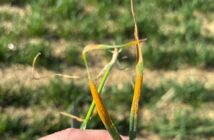A new post-emergence residual herbicide which can enhance black-grass control levels in winter wheat has been introduced this season by UPL Europe.
Xerton, which contains ethofumesate, best known as a sugar beet herbicide, is a novel active ingredient for the control of certain grass-weeds in the wheat crop.
“Xerton is a useful addition to the armoury, which comes to the market after years of investment in research and development,” says Louise Dalgliesh, UPL campaign manager.
“There is no known black-grass resistance to the molecule, which is taken up by emerging shoots (grasses) and roots (broad-leaved weeds) with translocation to the foliage.
“It has a different mode of action to the majority of actives used for weed control in wheat, which helps to support resistance management strategies.”
Xerton, which is available through most major distributors this autumn, can also be used against other grass weeds in wheat, including annual meadow-grass, she notes.
Agrovista is recommending Xerton plus flufenacet this season as a top-up to existing cultural and chemical controls to help achieve the 98% control needed to avoid yield loss and to reduce the seed bank in the soil.
Agrovista technical manager Mark Hemmant advises that the combination should be applied soon after the crop has emerged, at 2-6 leaves, preferably before black-grass is showing.
Combined with a robust pre-em stack plus Avadex, growers can expect to add 6% to black-grass control, the average figure achieved in 141 Agrovista trials over the past five seasons, he adds.
The additional control was achieved using the recommended 0.6 litres/ha rate of Xerton, which supplies 250g/ha of ethofumesate, plus adjuvant Remix, together with 120-240g/ha of flufenacet, depending on the severity of the black-grass problem.
“An extra 6% may not sound a lot, but when it comes to black-grass control every little bit helps. We are aiming this approach at winter wheat growers who can achieve good black-grass control, but who need to boost it to reach the desired 98% figure.”
Growers who are not expecting at least 92% control from their post-harvest cultural controls and pre-em
programme should not rely on Xerton/flufenacet or any other post-em programme to get them out of trouble, he advises.
“Xerton/flufenacet is for growers who can still achieve good, but not quite good enough, control. Anyone else needs to consider whether to winter crop at all, and step up out-of-crop control methods, for example switching to an overwintered cover crop followed by spring wheat.”
Xerton can be used to control other grass weeds, he adds. The same chemistry/rate combination used for black-grass is recommended for brome, while Herold (diflufenican + flufenacet) at 0.3 litres/ha should partner Xerton when tackling annual meadow-grass and chickweed.
No more than 1000g/ha of ethofumesate can be applied in a three-year period, which could preclude some sugar beet growers from using it in winter wheat crops, he notes.
UPL Europe is supporting the ethofumesate active long term and is examining further ways to develop new formulated mixes for the UK market, says Ms Dalgliesh.




